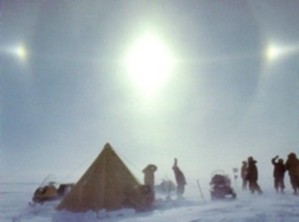
THE AIRLINE PILOTS FORUM & RESOURCE
Sun Dogs |
| Source: Excerpt from The Book " Weather " |
 |

Sun dogs, also known as parhelia or mock suns, appear as two bright spots on either side of the Sun, creating the eerie illusion of three suns in the sky. They often appear in conjunction with a 22 degree halo, and are produced under the same conditions. Sun dogs are the result of sunlight passing through a thin layer of ice crystals, either contained within cirrus cloud or falling at lower levels. Sun dogs will occur only when the hexagonal ice crystals are oriented horizontally --- that is, with the large, flat sides facing down --- so a large number of randomly falling ice crystals is necessary to sustain sun dogs. When well developed, the two sun dogs may appear delicately tinted with red on the inside and blue on the outside. Sometimes, only one sun dog will appear, or one will be considerably brighter than the other. More often, they will appear just as two bright or luminous areas on either side of the Sun, with no distinguishable color. It is possible for an unusually bright moon to create the same effect, but "moon dogs", as they are known, are very rare. Sometimes, sun dogs will gain height with the Sun during the day, although this can continue only up to an angle of 45 degrees above the horizon. Once the Sun climbs beyond this level, the refracted light will not be visible to the observer on the ground. If cirrus cloud is creating the sun dogs, it may indicate the approach of a frontal system or a developing low-pressure cell, but generally this is not a reliable method of forecasting. |
Acknowledgement: John W. Zillman, William J. Burroughs,
Bob Crowder, Ted Robertson, Eleanor Vallier-Talbot and Richard Whitaker.
